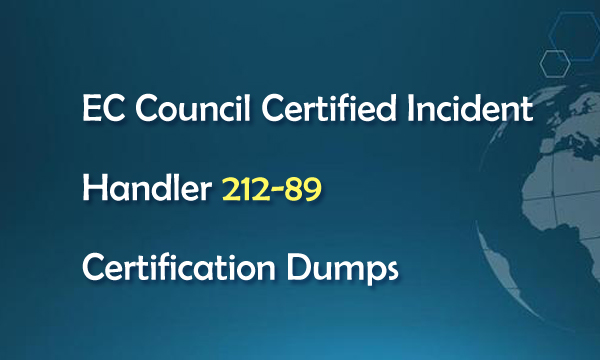You are here :Home > Exam information > EC Council Certified Incident Handler 212-89 Certification Dumps
EC Council Certified Incident Handler 212-89 Certification Dumps
August 06,2020
EC Council Certified Incident Handler 212-89 certification dumps are available, which are the best study guides in EC Council 212-89 exam preparation. The EC-Council Certified Incident Handler certification is designed to provide the fundamental skills to handle and respond to computer security incidents in an information system. EC Council 212-89 exam is easy for you to pass with the following guides.

EC-Council ECIH 212-89 Exam
ECIH 212-89 exam is available at the ECC exam center. There are 100 questions in real EC Council Certified Incident Handler 212-89 exam. You have 3 hours to complete the test. A certified Incident Handler will be able to create incident handling and response policies and deal with various types of computer security incidents such as network security incidents, malicious code incidents, and insider attack threats.
ECIH 212-89 Exam Topics
Incident Response and Handling 16%
Process Handling 14%
Forensic Readiness and First Response 13%
Email Security Incidents 10%
Application Level Incidents 8%
Network & Mobile Incidents 16%
Insider Threats 7%
Malware Incidents 8%
Incidents Occurred in a Cloud Environment 8%
Share EC Council ECIH 212-89 Certification Dumps
EC Council ECIH 212-89 certification dumps include 163 Q&As, which can help you test all the above topics. Share some EC Council ECIH 212-89 certification dumps questions below.
1.Identify the malicious program that is masked as a genuine harmless program and gives the attacker unrestricted access to the user’s information and system. These programs may unleash dangerous programs that may erase the unsuspecting user’s disk and send the victim’s credit card numbers and passwords to a stranger.
A. Cookie tracker
B. Worm
C. Trojan
D. Virus
Answer: C
2.Quantitative risk is the numerical determination of the probability of an adverse event and the extent of the losses due to the event. Quantitative risk is calculated as:
A. (Probability of Loss) X (Loss)
B. (Loss) / (Probability of Loss)
C. (Probability of Loss) / (Loss)
D. Significant Risks X Probability of Loss X Loss
Answer: A
3.An incident recovery plan is a statement of actions that should be taken before, during or after an incident. Identify which of the following is NOT an objective of the incident recovery plan?
A. Creating new business processes to maintain profitability after incident
B. Providing a standard for testing the recovery plan
C. Avoiding the legal liabilities arising due to incident
D. Providing assurance that systems are reliable
Answer: A
4.Risk is defined as the probability of the occurrence of an incident. Risk formulation generally begins with the likeliness of an event’s occurrence, the harm it may cause and is usually denoted as Risk = ∑(events)X (Probability of occurrence) X?
A. Magnitude
B. Probability
C. Consequences
D. Significance
Answer: A
5.An audit trail policy collects all audit trails such as series of records of computer events, about an operating system, application or user activities.Which of the following statements is NOT true for an audit trail policy:
A. It helps calculating intangible losses to the organization due to incident
B. It helps tracking individual actions and allows users to be personally accountable for their actions
C. It helps in compliance to various regulatory laws, rules,and guidelines
D. It helps in reconstructing the events after a problem has occurred
Answer: A
- Related Exam Information
 My
User Center
My
User Center 



